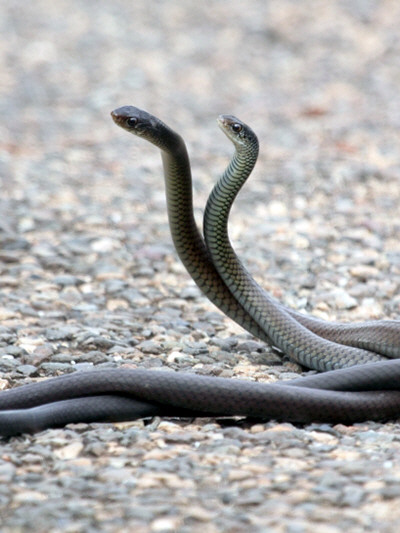 |
Family :
ELAPIDAE
Species : Demansia vestigiata
Maximum Size : 115 cm
The Black Whipsnake occurs in open woodlands,
savanna, cultivated areas and around lowland villages. It is diurnal and
mildly venomous.
This slender and fast-moving snake will typically flee from disturbance, but
larger specimens may stand their ground and rear up if suddenly disturbed.
Its head is narrow, with large eyes and pale lips. The tail is long and
slender. Its dorsal scales are dark brown to black and its ventral scales
are greyish. The tail may be lighter than the rest of the body.
This species feeds almost exclusively on lizards, supplemented with frogs
when available.
The genus Demansia currently includes 13 species, which are mainly
centred on Australia, however two species are known to occur on the island
of New Guinea - the Black Whipsnake Demansia vestigiata (formerly
D. atra), described here, and the smaller Black-necked Whipsnake
Demansia calodera.
(According to
Reptile Database, the Papuan Whipsnake Demansia papuensis
appears, rather confusingly, to be confined to Australia.)
The Black Whipsnake occurs in southern parts of both Papua New Guinea and
the Indonesian province of Papua. It also occurs in northern Australia.
Figs 1 and 2 : A pair of Black Whipsnake in a duel. This behaviour typically
takes place between two males in a show of strength over a female. Seen
at Varirata National Park at around 750 metres elevation.
Photos thanks to Jeff Crocombe.
Fig 3 : Aerial view of savanna habitat in southern Papua New Guinea - a
typical haunt for the Black Whipsnake. Such habitat comprises mainly
human influenced fire-climax vegetation interspersed with open forest.
References :
O'Shea, M., 1996. A Guide to the Snakes of Papua New Guinea. Independent
Publishing Group Pty Ltd.
Shea, G.M. & Scanlon 2007. Revision of the small tropical whipsnakes
previously referred to Demansia olivacea (Gray, 1842) and
Demansia torquata (Guenther, 1862) (Squamata: Elapidae). Rec.
Austral. Mus. 59 (2-3): 117-142 |